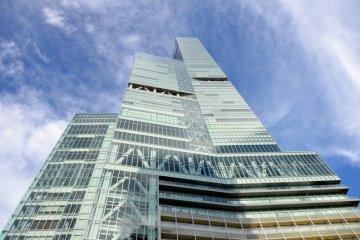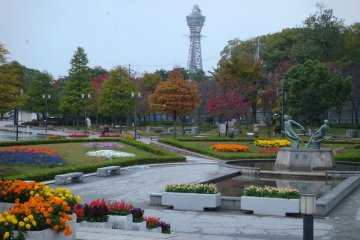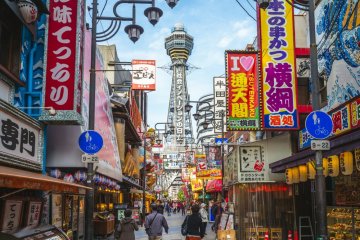

Sumiyoshi Taisha, also known as Sumiyoshi Grand Shrine, is one of the most famous shrines in Osaka and one of the oldest in Japan. During hatsumode, the first shrine visit of the new year, over two million people visit this unique shrine. The shrine grounds are a picture of tranquility with vermillion shrine buildings, natural beauty, and glimmering water.
History
Sumiyoshi Taisha is cited in two of Japan’s oldest books, the Kojiki and the Nihon Shoki, as well as one of the world’s oldest stories, Tale of Genji. Legend has it that Sumiyoshi Taisha was founded in 211 CE by Empress Jingu who dedicated it to the Sumiyoshi Sanjin, which is a collective name for the three Shinto gods of the sea and later, waka poetry. Although landlocked now, the shrine used to overlook the ocean. Later, Empress Jingu was also enshrined on the grounds. This act linked the shrine to her son, Emperor Ojin, who was deified as Hachiman, god of war. With the enshrinement of various kami (gods), the shrine is a popular place to pray for a variety of reasons, including safe seas, travel, poetry, fighting (such as martial arts), military, and general health and prosperity.
Sumiyoshi Taisha is the head shrine of over two thousand Sumiyoshi shrines across Japan.
One-of-a-kind architecture
Interestingly, Sumiyoshi Taisha was founded before the introduction of Buddhism in Japan, giving it a unique architectural style called Sumiyoshi-zukuri, which is free of influence from the Asian mainland. This purely Japanese style is registered as a national treasure and characterized by straight roofs, rather than curved ones, decorated with forked finials that resemble crossed poles, and five horizontal billets. The shrine’s four main halls are painted vermillion and surrounded by fences.
Explore the shrine
Sumiyoshi Taisha is home to dozens of shrine buildings, which are complemented by torii gates, rich nature, and stone lanterns. Stroll through the sacred grounds and allow the peaceful energy to rejuvenate your mind and body.
Sumiyoshi Taisha is a 3-minute walk from Sumiyoshi Taisha Station on the Nankai Main Line or Sumiyoshitorii-Mae Station on the Hankai Tramline.


일본은 6월 14일 오사카에서 열리는 연례 스미요시 사원 쌀 재배 축제에서 주요 농작물과의 깊은 관계를 재확인하고 있다.

The Abenobashi Terminal Building is located in Abenosuji Itchome, Osaka City. The building is a commercially used multifunctional building and not only houses numerous shops, but also a hotel and the Sharp Cooporation's sales office. The name of the skyscraper is Abeno Harukas, which is derived from the old Japanese word Harukatsu and means to brighten or clear. Construction of the building began in 2010 and it opened on March 7, 2014. With a height of 300 meters and 62 floors, the Abenobashi Terminal building is the tallest skyscraper in Japan and when all floors are taken together it has a walkable area of approximately 100,000 square meters.

Tenshiba is the entrance area to Tennoji Park, which was converted into a free recreation area for the people of Osaka in October 2015. It is laid out around an extensive lawn and surrounded by a variety of recreational facilities for the local population. In the shopping area there is Cafes, restaurants and a farmers market, and there is also a children's playground and a futsal court. There is also an animal park nearby, the Tennoji Zoo. In 2016, the redesigned park won one of Japan's annual Good Design Awards. Entrance is completely free and a free WiFi network is also offered to visitors.

Tsutenkaku Tower, standing at 103 meters tall, is an unmistakable symbol of Osaka and located in the Shinsekai area. The towering 8-sided structure’s facade is characterized by its exposed steel beams and Eiffel Tower-esque appearance. Visitors and residents alike flock to its observation deck for stunning panoramic views of the area. History Tsutenkaku, originally built in 1912 at 63 meters tall, was renowned for its impressive height, making it one of the tallest structures in Asia at the time. The structure’s appearance was modeled after famous French architecture, with the tower portion matching the Eiffel Tower and the base reminiscent of the Arc de Triomphe. The tower was erected as a centerpiece of the bustling area and was attached to the popular amusement park, Luna Park, via a cable car. Unfortunately, the tower was damaged in 1943 by a fire and later dismantled for its steel during WWII. Years later in 1956, after locals campaigned for a new tower, the current Tsutenkaku was constructed at a taller 103 meters tall and designed by famous architect Tachu Naito, who also designed Tokyo Tower. You can view photos, videos, and a diorama of the original tower and Luna Park on Tsutenkaku’s third floor. Today Presently, Tsutenkaku stands as a beacon of the lively area and is a must see spot if you are visiting the Shinsekai. During the day, the structure stands silver against the sky, while at night it shines bright neon thanks to its numerous LED lights that change color with the seasons. The tower is open year-round from 10:00 to 20:00 with admission until 19:30. General observatory tickets cost 900 JPY for adults (high school students and above) and 400 JPY for infants 5 years old and over and junior high and elementary school students. For an additional 300 JPY (adults) or 200 JPY (children and young adults), you can visit Tenbo Paradise and Tip The Tsutenkaku. Listed below are some highlights to help guide your adventures. Explore the Surrounding Area While in the area, be sure to check out the Shinsekai neighborhood for its local wares, delicious eats, and lively atmosphere. Stroll along JanJan Yokocho (JanJan Alley), a covered shopping street, and enjoy the clothes stores, arcade games, and kushikatsu restaurants, which are known for their fried skewers of breaded meat and vegetables. The street is also populated by multiple Shogi, Japanese chess, salons. For a break from the bustling Osaka streets, visit nearby Tennoji Park for a relaxing walk.